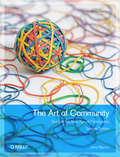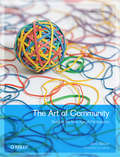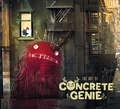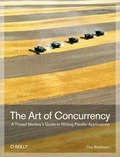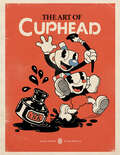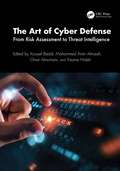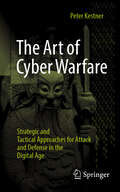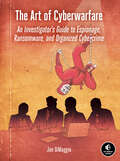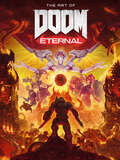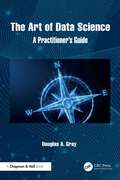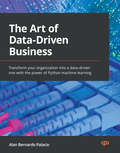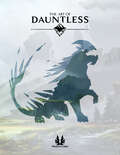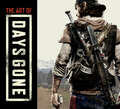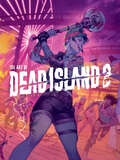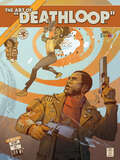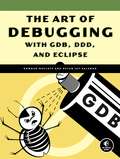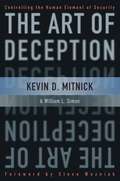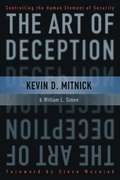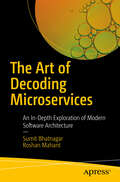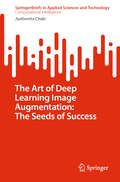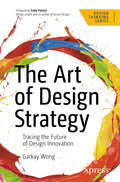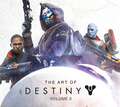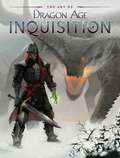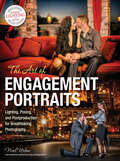- Table View
- List View
The Art of Community: Building the New Age of Participation
by Jono BaconOnline communities provide a wide range of opportunities for supporting a cause, marketing a product or service, or building open source software. The Art of Community helps you recruit members, motivate them, and manage them as active participants. Author Jono Bacon offers experiences and observations from his 14-year effort to build and manage communities, including his current position as manager for Ubuntu.Discover how your community can become a reliable support network, a valuable source of new ideas, and a powerful marketing force. This expanded edition shows you how to keep community projects on track, make use of social media, and organize collaborative events. Interviews with 12 community management leaders, including Linus Torvalds, Tim O’Reilly, and Mike Shinoda, provide useful insights.Develop specific objectives and goals for building your communityBuild processes to help contributors perform tasks, work together, and share successesProvide tools and infrastructure that enable members to work quicklyCreate buzz around your community to get more people involvedHarness social media to broadcast information, collaborate, and get feedbackUse several techniques to track progress on community goalsIdentify and manage conflict, such as dealing with divisive personalities
The Art of Community: Building the New Age of Participation (Theory in Practice)
by Jono BaconOnline communities offer a wide range of opportunities today, whether you're supporting a cause, marketing a product or service, or developing open source software. The Art of Community will help you develop the broad range of talents you need to recruit members to your community, motivate and manage them, and help them become active participants. Author Jono Bacon offers a collection of experiences and observations from his decade-long involvement in building and managing communities, including his current position as manager for Ubuntu, arguably the largest community in open source software. You'll discover how a vibrant community can provide you with a reliable support network, a valuable source of new ideas, and a powerful marketing force.The Art of Community will help you:Develop a strategy, with specific objectives and goals, for building your communityBuild simple, non-bureaucratic processes to help your community perform tasks, work together, and share successesProvide tools and infrastructure that let contributors work quicklyCreate buzz around your community to get more people involvedTrack the community's work so it can be optimized and simplifiedExplore a capable, representative governance strategy for your communityIdentify and manage conflict, including dealing with divisive personalities
The Art of Concrete Genie
by PixelOpusWalk among the mysterious streets of Denska and collect the real pages of artwork behind PixelOpus' endearing video game Concrete Genie!This art book studies the power of self-expression, creativity and the game's core fantasy of making anyone believe they can be an artist - just like the talented protagonist of the game, Ash. Return to the characters, monsters, and lore of Denska to uncover the secrets behind PixelOpus' 'living paint' mechanics that allow the walls of Denska to come to life with player creations. Witness a special, behind-the-scenes look at the development of Concrete Genie from the small and passionate team that brought it to life.From the developers of a truly empowering journey about oppression and creativity, Dark Horse Books and PixelOpus are delighted to present The Art of Concrete Genie! This art book collects heart-warming, magnificent illustrations for fans of Ash and his wildly varied 'living paint' creations within Concrete Genie.
The Art of Concurrency: A Thread Monkey's Guide to Writing Parallel Applications
by Clay BreshearsIf you're looking to take full advantage of multi-core processors with concurrent programming, this practical book provides the knowledge and hands-on experience you need. The Art of Concurrency is one of the few resources to focus on implementing algorithms in the shared-memory model of multi-core processors, rather than just theoretical models or distributed-memory architectures. The book provides detailed explanations and usable samples to help you transform algorithms from serial to parallel code, along with advice and analysis for avoiding mistakes that programmers typically make when first attempting these computations.Written by an Intel engineer with over two decades of parallel and concurrent programming experience, this book will help you:Understand parallelism and concurrencyExplore differences between programming for shared-memory and distributed-memoryLearn guidelines for designing multithreaded applications, including testing and tuningDiscover how to make best use of different threading libraries, including Windows threads, POSIX threads, OpenMP, and Intel Threading Building BlocksExplore how to implement concurrent algorithms that involve sorting, searching, graphs, and other practical computationsThe Art of Concurrency shows you how to keep algorithms scalable to take advantage of new processors with even more cores. For developing parallel code algorithms for concurrent programming, this book is a must.
The Art of Cuphead
by Studio MDHRGet transported back to the golden age of 1930s animation with an art book celebrating the acclaimed run & gun game, Cuphead!Each page of this curated collection of artwork is designed to capture the vintage look and feel of the 1930's. Take a gander at the game's traditional hand-drawn frame-by-frame animation. Peek at the early concepts, production work, and early ideas that went into the making of Cuphead's characters, bosses, stages and more including never-before-seen content from the upcoming DLC! Relive the most cherished and challenging moments of Cuphead and Mugman's adventure to reclaim their souls from The Devil, all in a way you've never seen before! Guided by personal insights from game directors Chad and Jared Moldenhauer, take a one-of-a-kind trip through the Inkwell Isles and discover an all-new appreciation for Cuphead's animation style and challenging retro gameplay.Dark Horse Books and Studio MDHR are thrilled to present The Art of Cuphead! This vintage-style art extravaganza is the perfect book for fans of Cuphead!
The Art of Cyber Defense: From Risk Assessment to Threat Intelligence (Advances in Cybersecurity Management)
by Yassine Maleh Youssef Baddi Mohammed Amin Almaiah Omar AlmomaniThe Art of Cyber Defense: From Risk Assessment to Threat Intelligence offers a comprehensive exploration of cybersecurity principles, strategies, and technologies essential for safeguarding digital assets and mitigating evolving cyber threats. This book provides invaluable insights into the intricacies of cyber defense, guiding readers through a journey from understanding risk assessment methodologies to leveraging threat intelligence for proactive defense measures.Delving into the nuances of modern cyber threats, this book equips readers with the knowledge and tools necessary to navigate the complex landscape of cybersecurity. Through a multidisciplinary approach, it addresses the pressing challenges organizations face in securing their digital infrastructure and sensitive data from cyber‑attacks.This book offers comprehensive coverage of the most essential topics, including: Advanced malware detection and prevention strategies leveraging artificial intelligence (AI) Hybrid deep learning techniques for malware classification Machine learning solutions and research perspectives on Internet of Services (IoT) security Comprehensive analysis of blockchain techniques for enhancing IoT security and privacy Practical approaches to integrating security analysis modules for proactive threat intelligence This book is an essential reference for students, researchers, cybersecurity professionals, and anyone interested in understanding and addressing contemporary cyber defense and risk assessment challenges. It provides a valuable resource for enhancing cybersecurity awareness, knowledge, and practical skills.
The Art of Cyber Warfare: Strategic and Tactical Approaches for Attack and Defense in the Digital Age
by Peter KestnerThe Art of Cyber Warfare explores the strategic and tactical approaches for offense and defense in the digital age. Drawing on historical conflicts from Sun Tzu to Carl von Clausewitz, the author illustrates that, despite changed conditions such as time, location, means, and resources – but not the laws of physics – it is possible to learn from past actions and reactions.The author aims to demonstrate in this book that, in reality, we have only transferred old methods into our current era but have forgotten to translate their reasons, effects, and the resulting lessons. For, as it has been for thousands of years, the reasons for human-created conflicts remain the same: wealth, fame, power, honor, or desire. Can we learn something from history for present and future (cyber) wars?
The Art of Cyberwarfare: An Investigator's Guide to Espionage, Ransomware, and Organized Cybercrime
by Jon DiMaggioA practical guide to understanding and analyzing cyber attacks by advanced attackers, such as nation states.Cyber attacks are no longer the domain of petty criminals. Today, companies find themselves targeted by sophisticated nation state attackers armed with the resources to craft scarily effective campaigns. This book is a detailed guide to understanding the major players in these cyber wars, the techniques they use, and the process of analyzing their advanced attacks. Whether you&’re an individual researcher or part of a team within a Security Operations Center (SoC), you&’ll learn to approach, track, and attribute attacks to these advanced actors. The first part of the book is an overview of actual cyber attacks conducted by nation-state actors and other advanced organizations. It explores the geopolitical context in which the attacks took place, the patterns found in the attackers&’ techniques, and the supporting evidence analysts used to attribute such attacks. Dive into the mechanisms of: • North Korea&’s series of cyber attacks against financial institutions, which resulted in billions of dollars stolen • The world of targeted ransomware attacks, which have leveraged nation state tactics to cripple entire corporate enterprises with ransomware • Recent cyber attacks aimed at disrupting or influencing national elections globallyThe book&’s second part walks through how defenders can track and attribute future attacks. You&’ll be provided with the tools, methods, and analytical guidance required to dissect and research each stage of an attack campaign. Here, Jon DiMaggio demonstrates some of the real techniques he has employed to uncover crucial information about the 2021 Colonial Pipeline attacks, among many other advanced threats. He now offers his experience to train the next generation of expert analysts.
The Art of DOOM: Eternal
by Bethesda Softworks ID SOFTWAREA full-color digital art book containing concept art and commentary from the development of DOOM Eternal, the next entry in the iconic first-person shooter series.The newest chapter in the quintessential game franchise from id Software is here. Witness DOOM Eternal! This epic volume explores the art and development of the hotly anticipated sequel to the 2016 Game Award-winner for Best Action Game! Explore the twisted demonic invasion of Earth, the cultist UAC facilities, and plunge into otherworldly and unknown locations new to the DOOM universe. Admire the dangerous glimmering edges of the Slayer's arsenal and armor. Examine the ancient designs and breeds of Hell's soldiers and lords--all in gloriously designed full color images straight from the files of the game's artists themselves! Dark Horse Books and id Software join forces to present The Art of DOOM Eternal, encompassing every detail you've come to love from DOOM!
The Art of Data Analysis
by Kristin H. JarmanA friendly and accessible approach to applying statistics in the real worldWith an emphasis on critical thinking, The Art of Data Analysis: How to Answer Almost Any Question Using Basic Statistics presents fun and unique examples, guides readers through the entire data collection and analysis process, and introduces basic statistical concepts along the way.Leaving proofs and complicated mathematics behind, the author portrays the more engaging side of statistics and emphasizes its role as a problem-solving tool. In addition, light-hearted case studies illustrate the application of statistics to real data analyses, highlighting the strengths and weaknesses of commonly used techniques. Written for the growing academic and industrial population that uses statistics in everyday life, The Art of Data Analysis: How to Answer Almost Any Question Using Basic Statistics highlights important issues that often arise when collecting and sifting through data. Featured concepts include:* Descriptive statistics* Analysis of variance* Probability and sample distributions* Confidence intervals* Hypothesis tests* Regression* Statistical correlation* Data collection* Statistical analysis with graphsFun and inviting from beginning to end, The Art of Data Analysis is an ideal book for students as well as managers and researchers in industry, medicine, or government who face statistical questions and are in need of an intuitive understanding of basic statistical reasoning.
The Art of Data Science: A Practitioner's Guide
by Douglas A. GrayAlthough change is constant in business and analytics, some fundamental principles and lessons learned are truly timeless, extending and surviving beyond the rapid ongoing evolution of tools, techniques, and technologies. Through a series of articles published over the course of his 30+ year career in analytics and technology, Doug Gray shares the most important lessons he has learned – with colleagues and students as well – that have helped to ensure success on his journey as a practitioner, leader, and educator.The reader witnesses the Analytical Sciences profession through the mind’s eye of a practitioner who has operated at the forefront of analytically inclined organizations, such as American Airlines and Walmart, delivering solutions that generate hundreds of millions of dollars annually in business value, and an educator teaching students and conducting research at a leading university. Through real‑world project case studies, first‑hand stories, and practical examples, we learn the foundational truth underlying successful analytics applications. From bridging theory and practice, to playing a role as a consultant in digital transformation, to understanding how analytics can be economically transformational, identifying required soft skills like leadership skills, and understanding the reasons why data science projects often fail, the reader can better visualize and understand the nuanced, multidimensional nature of Analytical Sciences best practices, projects, and initiatives.The readers will gain a broad perspective on where and how to find success with Analytical Sciences, including the ability to ensure that we apply the right tool, at the right time and right place, and sometimes in different industries.Finally, through the author’s own career synopsis on becoming a practitioner and leader, and his distilled insights, the reader is offered a view into the future that analytics holds, along with some invaluable career advice regarding where to focus, how to make good choices, and how to measure success individually and organizationally.
The Art of Data-Driven Business: Transform your organization into a data-driven one with the power of Python machine learning
by Alan Bernardo PalacioLearn how to make the right decisions for your business with the help of Python recipes and the expertise of data leadersKey FeaturesLearn and practice various clustering techniques to gather market insights Explore real-life use cases from the business world to contextualize your learningWork your way through practical recipes that will reinforce what you have learnedBook DescriptionOne of the most valuable contributions of data science is toward helping businesses make the right decisions. Understanding this complicated confluence of two disparate worlds, as well as a fiercely competitive market, calls for all the guidance you can get.The Art of Data-Driven Business is your invaluable guide to gaining a business-driven perspective, as well as leveraging the power of machine learning (ML) to guide decision-making in your business. This book provides a common ground of discussion for several profiles within a company.You'll begin by looking at how to use Python and its many libraries for machine learning. Experienced data scientists may want to skip this short introduction, but you'll soon get to the meat of the book and explore the many and varied ways ML with Python can be applied to the domain of business decisions through real-world business problems that you can tackle by yourself. As you advance, you'll gain practical insights into the value that ML can provide to your business, as well as the technical ability to apply a wide variety of tried-and-tested ML methods.By the end of this Python book, you'll have learned the value of basing your business decisions on data-driven methodologies and have developed the Python skills needed to apply what you've learned in the real world.What you will learnCreate effective dashboards with the seaborn libraryPredict whether a customer will cancel their subscription to a serviceAnalyze key pricing metrics with pandasRecommend the right products to your customersDetermine the costs and benefits of promotionsSegment your customers using clustering algorithmsWho this book is forThis book is for data scientists, machine learning engineers and developers, data engineers, and business decision makers who want to apply data science for business process optimization and develop the skills needed to implement data science projects in marketing, sales, pricing, customer success, ad tech, and more from a business perspective. Other professionals looking to explore how data science can be used to improve business operations, as well as individuals with technical skills who want to back their technical proposal with a strong business case will also find this book useful.
The Art of Dauntless
by Phoenix LabsMaster the hunt and forge your legend!Dauntless is a fresh take on the action-RPG genre, developed by industry veterans from Riot Games, BioWare, and other acclaimed studios. After a cataclysmic event, mankind survives in a harsh, yet majestic world of floating islands. Ferocious beasts known as Behemoths now stalk the earth. You are a Slayer, an elite warrior who risks life and limb hunting the Behemoth threat. On your journey, you'll forge an extraordinary arsenal of weapons and gear to overcome formidable challenges threatening our survival. Now, you have a unique opportunity to witness the creation of this magnificent epic like never before.Dark Horse Books and Phoenix Labs are thrilled to present the most intimate look at the development of the game with The Art of Dauntless, a meticulously curated tome full of hundreds of pieces of concept art each paired with exclusive commentary from the team that created it. You won't want to miss this unique opportunity to experience the Shattered Isles in a whole new way!
The Art of Days Gone
by Bend StudioA masterfully designed book collecting over 200 pages of art and commentary from the creators of the brutal and thrilling Days Gone!Set in the beautiful and rugged landscape of the Pacific Northwest high desert, a global pandemic has wreaked havoc on everyone and everything in sight. Now, former outlaw biker turned bounty hunter Deacon St. John must fight for survival against all odds. Witness the creation of Deacon's epic adventure with The Art of Days Gone! From Dark Horse Books and Bend Studio (Syphon Filter, Resistance: Retribution, Uncharted: Golden Abyss), The Art of Days Gone takes an unflinching look at the lovingly detailed production of this hugely anticipated game, featuring hundreds of pieces of concept art and exclusive commentary directly from the team who created it!
The Art of Dead Island 2
by Alex CalvinI Love HELL-A!This gory volume is dripping with insights showing just how the video game world of Dead Island 2 came to life!Featuring never before seen concept art on each of the Slayers, their gear and weapons, the ruined and iconic streets of post-outbreak Los Angeles, and the shambling hordes of dangerous undead that call them home! Also, this book showcases insights from the creators of the game, with captions and text written by Alex Calvin (Runescape: The First 20 Years).Dark Horse Books, Deep Silver, and Dambuster Studios proudly present: The Art of Dead Island 2!
The Art of Deathloop
by Arkane Studios Bethesda SoftworksA full-color, oversized hardcover that explores the creation of Deathloop, the groundbreaking first-person shooter from Arkane Studios and Bethesda Softworks. Winner of Best Game Direction and Best Art Direction in the 2021 Game Awards!In The Art of Deathloop, Dark Horse Books takes readers inside the latest critically acclaimed title from the creators of Dishonored and Prey. The mysterious island of Blackreef comes to life through never-before-seen concept art, allowing readers to get up close and personal with all the equipment, adversaries, and locations Colt will encounter while hunting his targets, breaking the island&’s timeloop, and evading the deadly assassin Julianna! The experience is deepened with the inclusion of select 3D imagery and an exclusive pair of retro-styled anaglyphic 3D glasses! Dark Horse Books, Arkane Studios, and Bethesda present The Art of Deathloop—a unique examination of the landmark shooter!
The Art of Debugging with GDB, DDD, and Eclipse: For Professionals And Students
by Norman Matloff Peter Jay SalzmanDebugging is crucial to successful software development, but even many experienced programmers find it challenging. Sophisticated debugging tools are available, yet it may be difficult to determine which features are useful in which situations. The Art of Debugging is your guide to making the debugging process more efficient and effective.The Art of Debugging illustrates the use three of the most popular debugging tools on Linux/Unix platforms: GDB, DDD, and Eclipse. The text-command based GDB (the GNU Project Debugger) is included with most distributions. DDD is a popular GUI front end for GDB, while Eclipse provides a complete integrated development environment.In addition to offering specific advice for debugging with each tool, authors Norm Matloff and Pete Salzman cover general strategies for improving the process of finding and fixing coding errors, including how to:–Inspect variables and data structures–Understand segmentation faults and core dumps–Know why your program crashes or throws exceptions–Use features like catchpoints, convenience variables, and artificial arrays–Avoid common debugging pitfallsReal world examples of coding errors help to clarify the authors’ guiding principles, and coverage of complex topics like thread, client-server, GUI, and parallel programming debugging will make you even more proficient. You'll also learn how to prevent errors in the first place with text editors, compilers, error reporting, and static code checkers.Whether you dread the thought of debugging your programs or simply want to improve your current debugging efforts, you'll find a valuable ally in The Art of Debugging.
The Art of Deception: Controlling the Human Element of Security
by Kevin D. Mitnick William L. SimonInviting you into the complex mind of the hacker, Mitnick provides realistic scenarios of cons, swindles, and social engineering attacks on businesses--and the consequences. Focusing on the human factors involved with information security, Mitnick explains why all the firewalls and encryption protocols in the world will never be enough to stop a savvy grifter intent on rifling a database or an irate employee determined to crash a system. He illustrates just how susceptible even the most locked-down information systems are to a determined con artist impersonating an IRS agent or any other seemingly innocent character. Narrated from the points of view of both the attacker and the victim, The Art of Deception explores why each attack was so successful--and how it could have been averted--in an engaging and highly readable manner reminiscent of a true-crime novel.
The Art of Deception: Controlling the Human Element of Security
by Kevin D. Mitnick William L. Simon Steve WozniakThe world's most infamous hacker offers an insider's view of the low-tech threats to high-tech securityKevin Mitnick's exploits as a cyber-desperado and fugitive form one of the most exhaustive FBI manhunts in history and have spawned dozens of articles, books, films, and documentaries. Since his release from federal prison, in 1998, Mitnick has turned his life around and established himself as one of the most sought-after computer security experts worldwide. Now, in The Art of Deception, the world's most notorious hacker gives new meaning to the old adage, "It takes a thief to catch a thief."Focusing on the human factors involved with information security, Mitnick explains why all the firewalls and encryption protocols in the world will never be enough to stop a savvy grifter intent on rifling a corporate database or an irate employee determined to crash a system. With the help of many fascinating true stories of successful attacks on business and government, he illustrates just how susceptible even the most locked-down information systems are to a slick con artist impersonating an IRS agent. Narrating from the points of view of both the attacker and the victims, he explains why each attack was so successful and how it could have been prevented in an engaging and highly readable style reminiscent of a true-crime novel. And, perhaps most importantly, Mitnick offers advice for preventing these types of social engineering hacks through security protocols, training programs, and manuals that address the human element of security.
The Art of Decoding Microservices: An In-Depth Exploration of Modern Software Architecture
by Sumit Bhatnagar Roshan MahantStay competitive in today’s software industry by mastering microservices. As microservices architecture becomes the modern standard, this book demystifies the transition from monoliths to microservices with clear guidance and practical examples for easier adoption and implementation. The book starts with the basics, explaining what microservices are, their benefits, and how they compare to monolithic architectures. From there, you will explore a wide range of topics including service discovery, load balancing, authentication and authorization, resilience, fault tolerance, and much more as well as practical Java examples throughout. Each chapter is meticulously crafted to offer a balance of theory and hands-on application, ensuring you not only understand the concepts but also apply them effectively in real-world scenarios. By the end of the book, you will be ready to design, implement, and manage scalable and efficient microservices-based systems. Additionally, you will gain a forward-looking perspective on emerging trends and the integration of microservices in AI and IoT. What You Will Learn Compare microservices and monolithic systems, understanding the basics, benefits and key differences Understand key principles for decomposing monoliths and designing for failure Master synchronous vs. asynchronous communication and when to use each Explore containerization, orchestration with Kubernetes, and scaling strategies Secure microservices and monitor health and performance in distributed systems Who This Book Is For Novice and experienced developers who are new to microservices and want to master the topic to drive successful software projects. The book is programming language-agnostic, and can be understood by developers of any language, but those with some familiarity with Java will benefit more from the specific examples provided.
The Art of Deep Learning Image Augmentation: The Seeds of Success (SpringerBriefs in Applied Sciences and Technology)
by Jyotismita ChakiThis book addresses the critical challenge of limited training data in deep learning for computer vision by exploring and evaluating various image augmentation techniques, with a particular emphasis on deep learning-based methods. Chapter 1 establishes the core problem of data scarcity, outlining its negative impacts on model performance, and introduces traditional image augmentation techniques like geometric transformations, color space manipulations, and other methods such as noise injection. It highlights the limitations of these traditional approaches, including limited variation, lack of control, and inability to introduce new information, before introducing the advantages of deep learning-based augmentation, such as superior control, task adaptability, enhanced realism, and automation. Chapter 2 delves into GAN-based image augmentation, discussing how GANs generate realistic synthetic images for various applications like super-resolution and image-to-image translation, while also addressing the challenges associated with GAN training and potential future directions. Chapter 3 explores autoencoder-based image augmentation, covering techniques like VAEs, DAEs, and AAEs, and highlighting architectural considerations and challenges such as overfitting. Chapter 4 showcases the diverse applications of deep learning-based image augmentation and how it enhances various computer vision tasks by improving generalization, robustness, and accuracy. Chapter 5 discusses strategies for evaluating and optimizing deep learning image augmentation, including traditional metrics, image quality metrics, and hyperparameter tuning techniques. Finally, Chapter 6 explores cutting-edge advancements, covering AutoAugment, interpretable augmentation, attention-based augmentation, counterfactual augmentation, and human-in-the-loop augmentation, emphasizing the role of human expertise in creating high-quality augmented data.
The Art of Design Strategy: Tracing the Future of Design Innovation (Design Thinking)
by Garkay WongAlthough business leaders and designers may appear to have different objectives, they actually share a common goal: ensuring the long-term success and profitability of their organization. This book highlights the shared objective, examining the progression of Design Strategy to bridge the gap between design practice and executive decision-making. Featuring the TRACES framework, it aligns design initiatives with overarching business goals, enhancing design-led strategies. The topic is a timely one. A recent article published by FastCompany has touched a nerve among design leaders, highlighting the urgent challenges and anxieties they face about the future of design. It’s sparked a conversation on the need for a new direction within the industry. As we stand on the precipice of the next design shift and design leaders ponder their next steps, The Art of Design Strategy offers a much-needed perspective, providing insights on how to elevate design to a strategic level and secure its place at the heart of business innovation. What You’ll Learn Understand the key principles of design strategy and management. Build a design-led work culture within your organization. Examine the TRACES framework to align design initiatives with your business goals. Gain deeper insights of the future landscape of the design industry. Who This book Is For Designers who are interested in design management and its implications, transitioning from design craft to management roles, and managers and design leaders who are looking to understand the strategic value of design in various business areas.
The Art of Destiny, Volume 3
by Michael OwenImmerse yourself in the stunning, dynamic world of Destiny with never-before-seen art and exclusive interviews from the Bungie team.The Art of Destiny, Volume 3 is a celebration of the stunning, dynamic visual style beloved by Destiny fans. Featuring hundreds of pieces of concept art, the book picks up where the previous volume left off in 2017. It features everything from early sketches and illustrations of characters, to paintings of sweeping vistas used to shape the in-game worlds. With stunning imagery, interviews with the development team, and more, The Art of Destiny, Volume 3 is a must-have for Guardians everywhere! ORIGINAL CONCEPT ART: Includes many never-before-seen concept art of the various Alien tribes, including: the Fallen, the Hive, the Vex, the Cabal, and the Taken. EXCLUSIVE INTERVIEWS: Hear from the development team and creators of Destiny as they delve deeper into the Light and Darkness saga. PEOPLE, PLACES, AND WEAPONS: Experience an in-depth look at the compelling characters, detailed environments, and incredible weaponry that brings the war to save our solar system to life. A STUNNING COMPANION: This exquisitely crafted hardcover book is perfect for all Guardians and fans of Destiny. Complete your collection with this gorgeous third volume in the Art of Destiny series.
The Art of Dragon Age: Inquisition (Dragon Age)
by BiowareThe next generation of fantasy is here! Go behind the scenes of Dragon Age: Inquisition, the most ambitious game ever created by legendary developer BioWare!Featuring hundreds of never-before-seen artworks and captions from the developers themselves, this volume offers revealing insight into the inspiration and creation of every facet of Dragon Age: Inquisition, from the heroes, to the wondrous weapons they wield, the powerful beasts that they battle, and the extraordinary world that they inhabit.
The Art of Engagement Portraits
by Neal UrbanWith bold colors, inventive lighting, creative postproduction, and eye-catching poses, Neal Urban creates engagement portraits that go far beyond the expected. In this book, he takes you behind the scenes with dozens of couples to show you how each image was conceptualized, customized, and brought to life. Under Neal's careful eye, a patch of tall grass in a parking-lot becomes an exotic setting for two, the couple's favorite dive-bar is transformed into a backdrop for timeless romance, and city streets become cinematic wonders. Shooting in the late-afternoon, sunset, and evening hours, Urban works carefully with the natural light, ambient sources in the scene, off-camera flash, LED, and tungsten sources to beautifully sculpt the couple and bring his scenes to life. Spend a few hours perusing this book and you'll never approach engagement photography the same way again!
